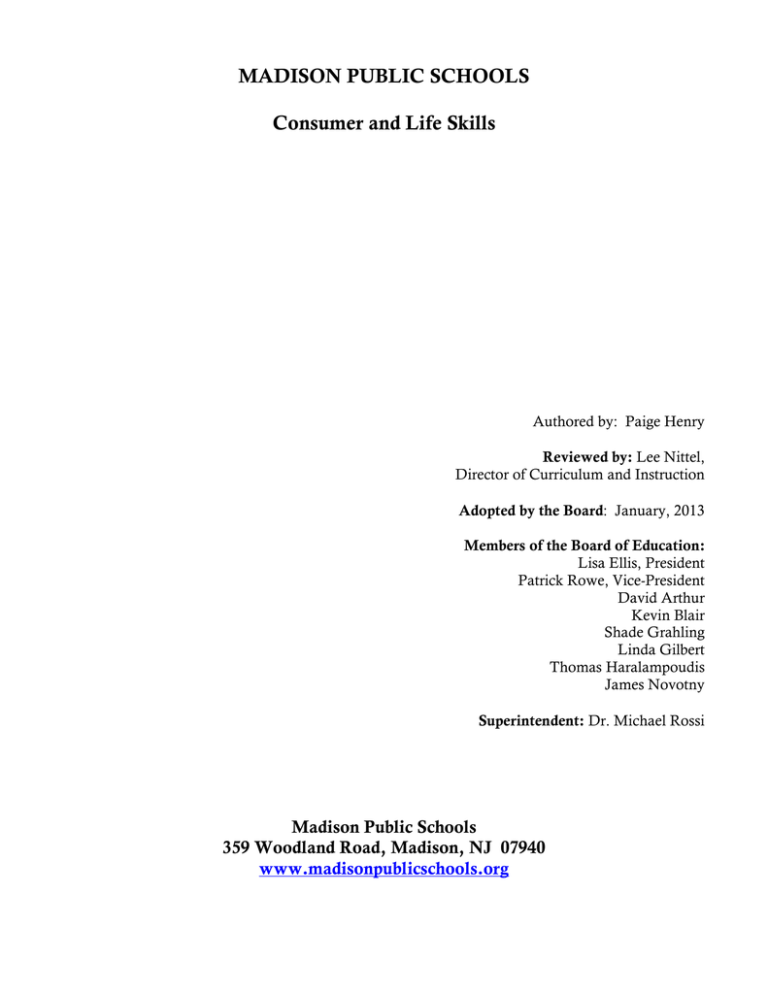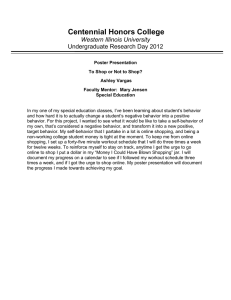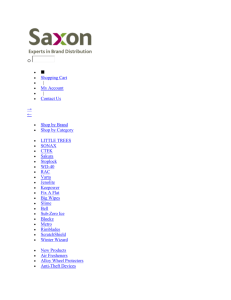MADISON PUBLIC SCHOOLS Consumer and Life Skills
advertisement

MADISON PUBLIC SCHOOLS Consumer and Life Skills Authored by: Paige Henry Reviewed by: Lee Nittel, Director of Curriculum and Instruction Adopted by the Board: January, 2013 Members of the Board of Education: Lisa Ellis, President Patrick Rowe, Vice-President David Arthur Kevin Blair Shade Grahling Linda Gilbert Thomas Haralampoudis James Novotny Superintendent: Dr. Michael Rossi Madison Public Schools 359 Woodland Road, Madison, NJ 07940 www.madisonpublicschools.org I. OVERVIEW Consumer and Life Skills is a cycle course designed for middle school students who are interested in gaining practical, hands-on experience in making sound economic and personal choices. Throughout the course, students will develop habits of inquiry, collaborate in making decisions and think creatively. Students will learn how to recognize problems, identify and evaluate possible solutions, and evaluate the effectiveness and impact of their choices. Consumer and Life Skills is a comprehensive course encompassing topics such as budgeting resources, wise spending habits, saving and investment vehicles and skills that promote personal well being. An essential underlying theme of the course is character development and ethics, including responsibility, respect, fairness, caring and citizenship. Within the framework of consumer education and resource management, focus is given to charitable giving and community service. II. RATIONALE As adolescents gain independence, many responsibilities and expectations are placed upon them as they prepare for adult life and become functioning members of society. This course promotes positive habits essential to balancing the rights and responsibilities that come along with independence and adulthood. By learning and practicing habits such as budgeting and planning, wise spending practices, saving and investing resources, charitable giving and community service, students will be better prepared to make informed and responsible decisions as they approach adulthood. Through the activities in this course, students will understand components of financial education and make sound economic choices. As much of the coursework is structured as collaborative teamwork, students will sharpen their self-awareness, learn to accept constructive criticism, and deal w/ potential conflict. Much focus is given to demonstration of key components of character education & ethics, including personal responsibility, respect, fairness, caring, and citizenship. III. STUDENT OUTCOMES (Linked to the New Jersey Core Curriculum Standards-Language Arts Literacy) Students will explore various tools for savings, such as savings and checking accounts, CDs, money market accounts (Standard 9.2, E1, E2; Standard 6.5 A3). Students will establish and maintain a checking account at a local bank branch (Standard 9.2, E2). Students will identify the best vehicle for saving resources given individual goals (Standard 9.2 E1). Students will explore associated costs, benefits and differences between cash, credit and debit purchases (Standard 9.2, E3 and E4; Standard 6.5, A4). Using resources including newspapers, magazines and the Internet, students will compare prices of similar items from different sellers (Standard 9.2; A1, E5). Students will manage a budget and evaluate related spending decisions against available resources and expected expenses (Standard 9.2 A1, E1, E2, E3; Standard 6.5 A1). Students will explore consumer topics such as unit cost and retail/wholesale pricing strategies and how increased awareness can enable wise spending decisions (Standard 9.2 A1, E5) By focusing on common consumer traps such as telemarketing scams, false advertising/quackery, sweepstakes, credit card solicitations and CD clubs, students will learn to recognize misleading claims and hidden catches designed to take advantage of uninformed consumers (Standard 9.2 A4). Students will learn to make balanced, wise decisions by balancing needs/responsibilities, goals/potential roadblocks, and objectives/available resources (Standard 9.2, A1, A2, A3, A5, B1, D1, D4). By learning about Cost of Living Index, students will compare cost of living in Morris County to other areas in New Jersey and the US and the financial resources needed to manage a household (Standard 6.6 B1, B6; 6.6 E5). As part of a collaborative team project, students will learn about opportunities for charitable giving and community service and visit a local food pantry for a tour and community service experience (Standard 9.2 B2, C1-C6, D1, D2). NJ CORE CURRICULUM CONTENT STANDARDS: STANDARD 9.2 (Consumer, Family, and Life Skills) All students will demonstrate critical life skills in order to be functional members of society: 9.2 A. Critical Thinking 1. Communicate, analyze data, apply technology, and problem solve. 2. Describe how personal beliefs and attitudes affect decision-making. 3. Identify and assess problems that interfere with attaining goals. 4. Recognize bias, vested interest, stereotyping, and the manipulation and misuse of information. 5. Practice goal setting and decision-making in areas relative to life skills. 9.2 B. Self-Management 2. Demonstrate responsibility for personal actions and contributions to group activities. 9.2 C. Interpersonal Communication 1. Demonstrate respect and flexibility in interpersonal and group situations. 2. Organize thoughts to reflect logical thinking and speaking. 3. Work cooperatively with others to solve a problem. 4. Demonstrate appropriate social skills within group activities. 5. Practice the skills necessary to avoid physical and verbal confrontation in individual and group settings. 6. Participate as a member of a team and contribute to group effort. 9.2 D. Character Development and Ethics 1. Explain and demonstrate how character and behavior affects and influences the actions of others in the home, school, and community. 2. Describe and demonstrate appropriate character traits, social skills, and positive attitudes needed for the home, school, community, and workplace. 4. Describe how personal ethics influence decision-making. 9.2 E. Consumer and Personal Finance Skills 1. Identify and demonstrate personal finance skills in checkbook maintenance and investing. 2. Construct a simple personal savings/spending plan. 3. Understand that people make financial choices that have costs, benefits, and consequences. 4. Explain the difference in cost between cash and credit purchases. 5. Compare prices of similar items from different sellers. STANDARD 6.5 (Economics) All students will gain an understanding of key economic principles. 6.5 A. Economic Literacy 1. Discuss how needs and wants change as one ages and the impact of planning, spending and saving. 3. Compare ways to save money, including checking and savings accounts, stocks and bonds, and the relationship between risk and return in investments. 4. Describe the role credit plays in the economy and explain the difference in cost between cash and credit purchases. STANDARD 6.6 (Geography) All students will apply understanding of spatial relationships and other geographic skills to understand human behavior in relation to the physical and cultural environment. 6.6 B. Places and Regions 1. Compare and contrast the physical and human characteristics of places in regions in New Jersey, the United States, and the world. 6. Discuss the similarities and differences among rural, suburban, and urban communities. 6.6 E. Environment and Society 5. Describe world, national, and local patterns of resource distribution and utilization, and discuss the political and social impact. IV. ESSENTIAL QUESTIONS AND CONTENT Question: What are available methods for saving money? Content/Objective: Students will learn about basic banking functions, including savings, checking, money market accounts, certificates of deposit, as well as compound and simple interest rates. Suggested activities: Review various banking application forms and credit card forms. Conduct field trip to local bank. Question: How can I spend resources wisely and make sound purchasing decisions? Content/Objective: Students will learn about cash, credit and debit purchases and the associated costs and benefits of each. Students will learn how to research purchase decisions to ensure money is spent wisely. Suggested activities: Analyze advertising circulars, promotional coupons, retail websites; Research best prices on-line; compare results of different shopping strategies and purchase channels. Discuss Consumer Price Index and how prices of consumer goods shift over time given market conditions. Question: Content/Objective: decisions. How can I budget my available resources? Students will assess resources, expected income and expenses or upcoming purchase Suggested activities: Use spreadsheet to create and track sample budgets; needs, wants, desires. Question: How can I protect my resources and myself as a consumer? Content/Objective: Students will learn to recognize and evaluate telemarketing offers such as cell phone plans, credit cards solicitations and CD clubs. Students will analyze advertising claims and sweepstakes to identify hidden and misleading stipulations. Suggested activities: Analyze direct mail offers and advertising (print, online, text). Review consumer protection agencies such as Food and Drug Administration (FDA), Better Business Bureau (BBB), Consumer Product Safety Commission (CPSC). Question: What are opportunities for charitable giving and community service? Content/Objective: Students will explore: possible charitable giving opportunities, ways to earn money for charity and volunteer for local community activities. Suggested activities/culminating project: Analyze statistics and demographics: poverty levels in NJ and US; minimum salary requirements to survive in Morris County; Cost of Living Index. Brainstorm possible ways students can (and do) raise money to help charitable organizations, volunteer for local activities and perform community service. Students will package gift baskets of new clothing (from on-line shopping activity, completed earlier in course) to be donated to the Morris County Interfaith Food Pantry (MCIFP). During field trip to Interfaith Food Pantry, students will tour facility and learn about volunteer opportunities and will also spend a portion of time performing volunteer work. Students will hand deliver gift baskets to MCIFP staff. V. STRATEGIES 1. 2. 3. 4. 5. 6. 7. Class discussions Research on-line, print and television offers and advertising Guided practice Group work Collaborative projects Field trips Guest presentations VI. EVALUATION Assessment may include: In-class participation (written and oral) Cooperative work as a team member for in-class activities Performance managing budget and maintaining class checking account Student reflection following in-class exercises Cooperative work as a team member for culminating activity VII. REQUIRED RESOURCES Banking applications and informational brochures Newspaper (The Star Ledger, Sunday edition, with circulars) Sample print advertisements Consumer Reports magazine Direct mail solicitations (credit cards, CD clubs, sweepstakes, etc.) Internet access Microsoft Office programs, including Excel Funding for culminating activity (first cycle; local grant funds for future cycles pending) Transportation for field trip to local charitable organization The money for the on-line shopping activity will be provided through the school’s budget. An additional source would be to reach out to organizations dedicated to service in the community (Masons, Elks, etc) to see if partnerships can be established in coordination with the district's new mission statement. The school principal will coordinate these efforts. If these options do not produce enough funding to sustain on-line purchasing activities in future marking periods, students can still benefit from the experience of shopping online and would save their purchases to an online shopping cart and not go through to completion. Teams can still compare results by analyzing the shopping cart contents. The field trip to MCIFP could still happen as a service activity without gift baskets to deliver. VIII. SCOPE AND SEQUENCE The lessons and objectives of this course are intended to serve as guidelines and parameters for the instructor. The time allocated for each unit of study is flexible to allow the instructor to adapt the curriculum to the need of the students. The suggested activities listed for the lessons are examples that allow an instructor to carry out a given objective. These suggested activities are intended as a guide and point of reference, not as a limiting structure. Each instructor is encouraged to bring his or her creativity and professional judgment to develop projects that accomplish the objectives for this course. Lessons One through Four: Banking Smarts: Explore savings, checking, money market and certificates of deposit; compound and simple interest; credit and debit purchases, interest charges and late payment fees, credit scores. Conduct field trip to local bank branch to set up checking account and learn about savings methods. The checking account opened would be in the name of the school and contain funds for the online shopping activity. Students will maintain the account over the course of the cycle. Students would NOT open individual accounts, although we will provide them with plenty of information on options for saving money. Lessons Five through Seven: Budgeting: Differentiate Needs/Wants/Desires; research purchase decisions to spend wisely; comparison shop across purchasing channels: retail, online shopping, wholesale and consignment. Explore unit pricing and retail pricing strategies including coupons, rebates and special promotions. Discuss Consumer Price Index and how prices for consumer goods may fluctuate given time and market conditions. Lesson Eight and Nine: Character Education: Explore stories from around the world: In teams, students read, respond to and share folk tales with themes including caring for others, listening, respect for self and others, motivation, planning ahead and honesty. Conduct group discussions: How can messages apply to our personal lives? Lesson Ten and Eleven: Collaborative Decision-Making: Teams of four to six students collaborate in an online shopping activity. Given a pre-set spending limit, teams shop on-line for apparel using different strategies: One team will shop full-price items at a mid-tier retailer site (i.e. Old Navy.com); one team will purchase current promotional items from a similar retail site; one team will shop sale or clearance items from at a discount retail site (i.e. walmart.com). Orders will be placed and shipped to MJS as part of the final culminating activity, see lessons 17 and 18 below. Lessons Twelve through Fourteen: Being a Careful Consumer: Examine topics including truth in advertising and fine print disclaimers. Analyze credit card solicitations, sweepstakes offers and CD clubs. Discuss protection of personal information to prevent identity theft, fraud and personal harm. Review copyright and anti-piracy laws. Explain protections afforded by agencies such as CPSC, FDA and BBB and how consumers enlist their aid. Lesson Fifteen: Living in Morris County: a Demographic Study: Examine cost of living standards and minimum salary requirements needed to live in NJ and Morris County; poverty levels and demographics for Morris County. Link advancement in education to future job security and better earnings. Lesson Sixteen: Being a Compassionate and Caring Citizen: Examine opportunities for middle school students to perform community service or volunteer activities. Explore charitable fundraising and donating to charities. Discuss benefits to community as well as to students on the individual level. Lesson Seventeen: Assessment of Results: Online Shopping Activity (from lessons 10, 11): Compare team results: Which team purchased the most items within their budget? What was the total value of each team’s purchases? Is there a difference in quality or style of items? What conclusions can be drawn from the exercise? Students will arrange items in gift bags to be delivered to Morris County Interfaith Food Pantry. Lesson Eighteen: Field Trip: Morris County Interfaith Food Pantry (MCIFP) in Morris County: During this one-hour trip, students will tour facility, learn about opportunities for volunteer service and spend a portion of time sorting food donations. Students will present MCIFP staff with a donation of clothing gift bags from the teams’ online shopping activity, to be given to middle-school age children of MCIFP client families. Summary of culminating project: Students collaborate in teams of four to six students. Given a pre-set spending budget, students will visit online clothing retailers (i.e. oldnavy.com; walmart.com; gap.com). Each team will be given a different set of criteria, with the objective of purchasing clothing for their age group. Possible examples of criteria: Team 1: Shop off-season clearance markdowns only; Team 2: Shop current promotions; Team 3: Shop full price items; Team 4: Use special discount coupons. Each team will shop in accordance with their criteria and complete purchase transaction online, with a shipping address of MJS. Upon receipt of items, teams will reconvene to analyze results: Compare HOW each team did: Any observations about quantity of merchandise purchased from team to team? Quality? Size availability? Coupon savings? What did teams learn about shopping habits and interpreting retail price strategy as consumers?? Each team will package their merchandise in a gift basket to be presented to MCIFP. During a field trip, we will deliver as a class our gift baskets and complete a 1-hour facility tour to learn about how the MCIFP serves Morris County’s needy (elderly, working poor, families with children) and help sort food. We will also learn about additional opportunities for middle-school age kids to help MCIFP (restocks, food sorting, food drives). This pulls together concepts of using online resources for information, evaluating economic decisions, consumer and personal finance, budgeting and wise spending practices, cost of living standards and local poverty demographics, citizenship and caring in the community. Since project is framed as a collaborative team effort, interpersonal communication is a key skill as is effective conflict resolution. While planning sequence of lessons, instructor must arrange in advance field trips to bank branch and MCIFP. Instructor should also allow for ample time between the students’ placement of online order (suggested here as lessons 10 and 11) and arrival of merchandise when planning the follow-up lesson for comparing results of online shopping. Flexibility with lesson sequence may be necessary based on scheduling of activities. The above-suggested lessons are not meant to be limiting in terms of sequence or depth of topics.





